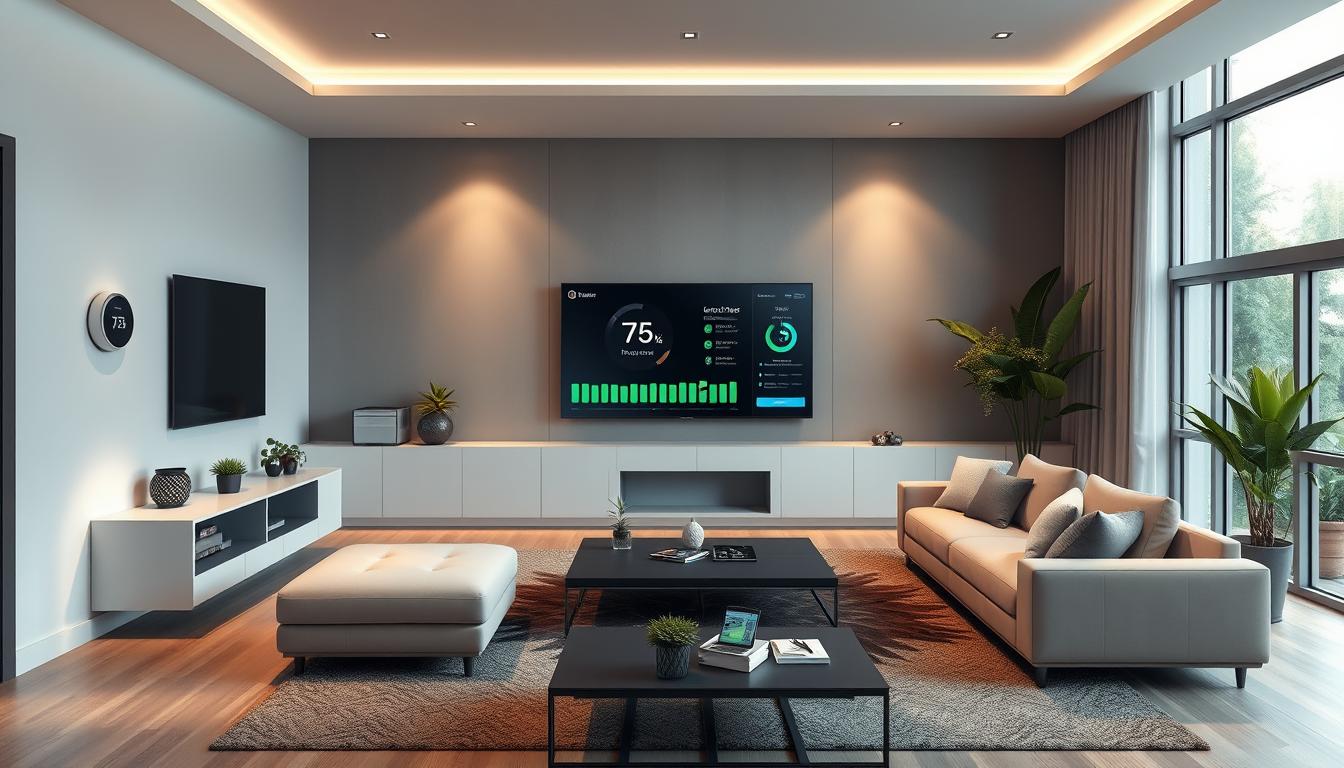As a homeowner, I aim to cut down my energy use and lower my bills. Smart home systems and energy-saving tech help me manage my energy. The U.S. Department of Energy says these systems can save up to 30% on bills.
These systems help me understand and control my energy use. With energy-saving tech, I can use less energy and save money. In this guide, I’ll show you how to master smart home energy management. We’ll explore how to cut energy use and bills with these systems and tech.
What are Smart Home Energy Management Systems?
Exploring smart home energy management, I aim to grasp its essence and significance. These systems track and manage energy use in real-time. They offer homeowners a detailed look at their energy consumption. This way, they can control their energy use and make their homes more efficient.
Definition and Importance
These systems are vital today. They help homeowners cut down on energy use and lower their bills. By automating energy control, they can set devices to turn on and off at the right times. This saves energy and money.
Key Components of the System
The core parts of a smart home energy management system include:
- Smart thermostats
- Smart lighting
- Smart appliances
These elements work together to give a full picture of energy use. Homeowners can then make smart choices about their energy use. With connected home solutions, they can check their energy use from anywhere. This makes managing energy easier and helps the environment.
Benefits of Smart Home Energy Management Systems
Exploring smart home energy management is exciting. It lets me track my energy use in real-time. This way, I can adjust to use less energy. A study by the National Resources Defense Council shows these systems can cut energy use by up to 20%.
Using less energy saves me money on bills. It also helps the planet. By wasting less energy, I help reduce my carbon footprint. This supports a greener future.
- Cost savings on energy bills: By optimizing energy consumption, I can reduce my energy bills and allocate the saved amount to other important expenses.
- Environmental impact and sustainability: Smart home energy management systems help reduce energy consumption, which in turn reduces greenhouse gas emissions and promotes a sustainable future.
With energy monitoring devices and smart tools, I can manage my energy use better. This saves me money and helps the environment. It’s a win-win for my wallet and the planet.
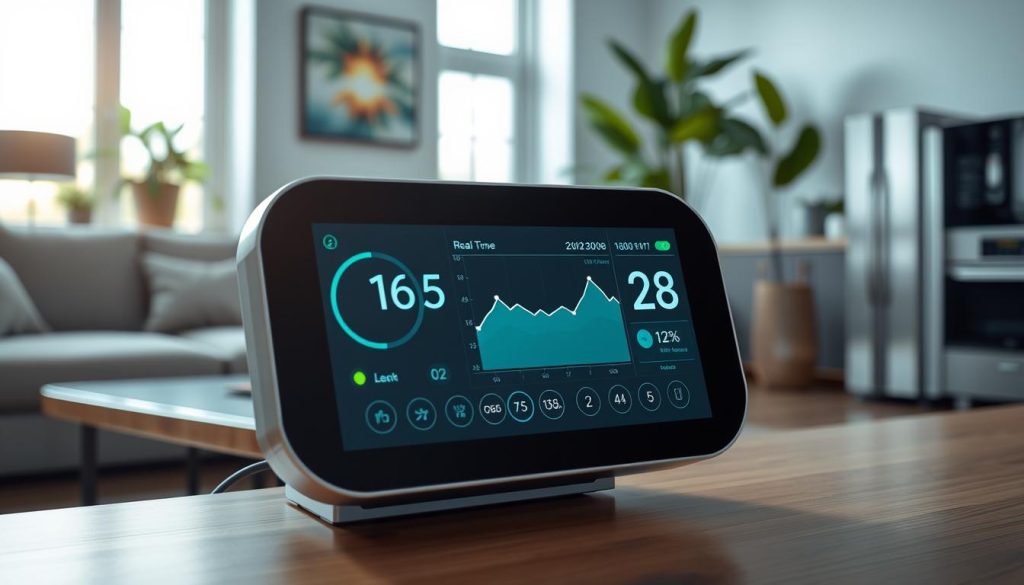
How to Choose the Right System for Me
Choosing a smart home energy management system can be tough. There are many options, and it’s easy to get lost. I need to think about my energy use, budget, and if it works with my current devices. Systems like home energy automation and smart home energy management offer features like energy tracking, control, and device integration.
I’ll look at how well the system tracks my energy use, controls my devices, and works with my smart home. By knowing what I need and comparing different systems, I can pick one that fits my goals and saves energy.
Understanding My Energy Needs
To pick the right system, I must know how I use energy. I need to find out where I can use less and which devices use the most. This way, I can choose a system that helps me use energy wisely.
Comparing Different Brands and Features
Big names like Samsung and Apple offer smart home energy systems. When comparing, I’ll look at things like:
- Energy monitoring and reporting
- Control and scheduling options
- Compatibility with my devices
- Customer support and reviews
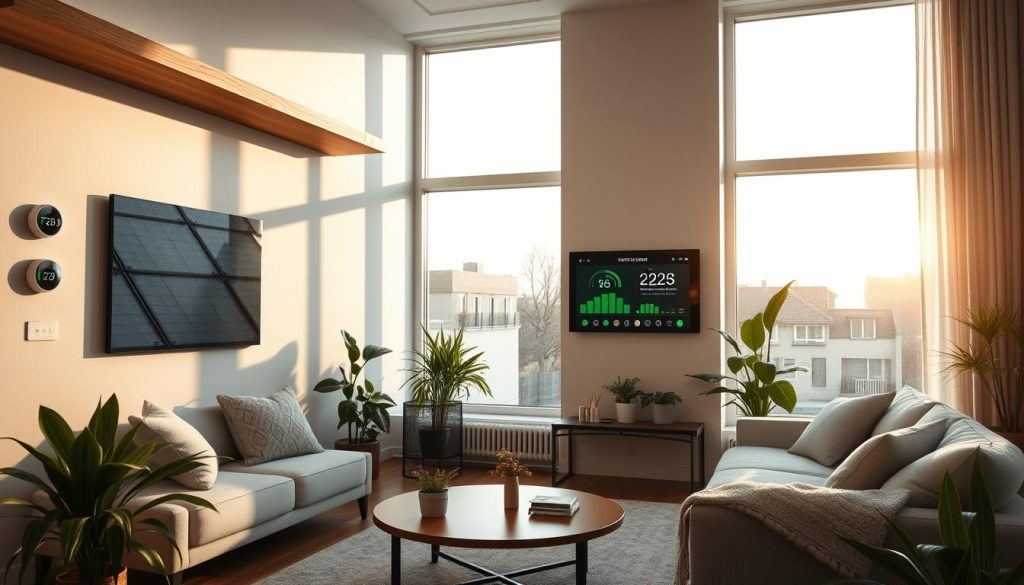
By carefully looking at these points and my energy use, I can find a system that saves me money and energy.
Installation Process for Smart Home Systems
I’m excited to explore the installation process for smart home systems. With the growth of energy-saving tech and automated control, it’s key to know how to set up a smart home. This ensures a smooth and efficient experience.
A survey by the Consumer Technology Association shows 70% of homeowners want professionals to install their smart homes. This highlights the value of professional help. While DIY can save money, it might take more time and could lead to problems.
DIY vs. Professional Installation
Choosing between DIY and professional installation is important. A pro can make the process easier and ensure everything works right. But, DIY might be cheaper and give you more control, if you’re tech-savvy.
Common Installation Challenges
Common issues include problems with compatibility and network connections. To avoid these, pick a system that fits with your devices and have a reliable network. This way, you can have a successful installation.
Here is a table summarizing the key considerations for installing a smart home energy management system:
| Installation Option | Pros | Cons |
|---|---|---|
| DIY Installation | Cost-effective, flexibility | Technical expertise required, time-consuming |
| Professional Installation | Efficient, hassle-free, expert guidance | Higher cost, dependence on installer |
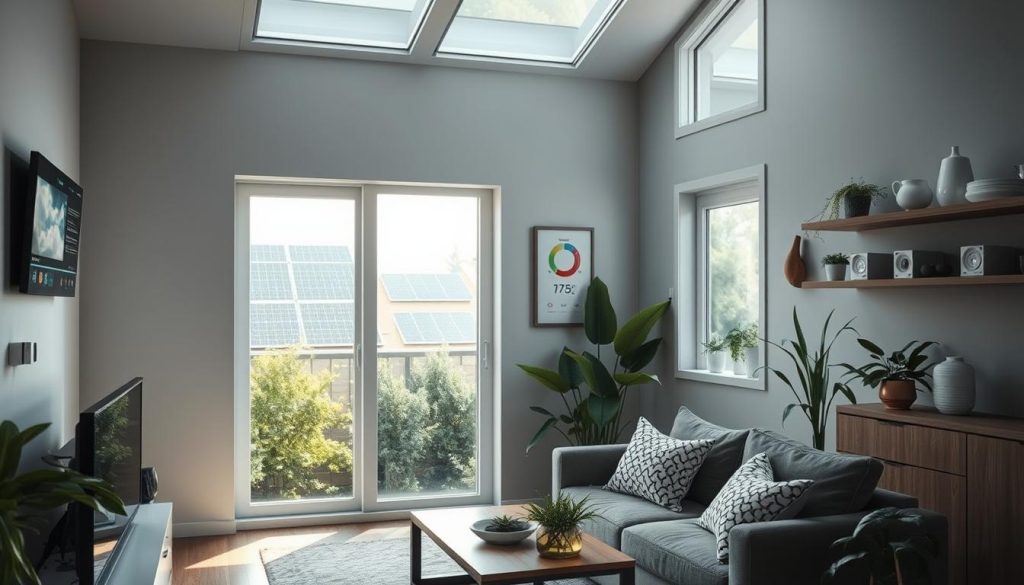
Integrating Smart Devices for Optimal Performance
To get the most out of my smart home energy management system, I need to integrate it with other smart devices in my home. This is where connected home energy solutions come in. They allow me to control and monitor my energy usage from one place. A report by Parks Associates shows that 60% of homeowners with smart home systems have already done this.
I’m looking into integrating smart devices for better performance. I’ve found that smart thermostats, smart lighting, and smart appliances are good options. By linking these devices, I can use smart energy tools to optimize my energy use. This makes my home more efficient and sustainable.
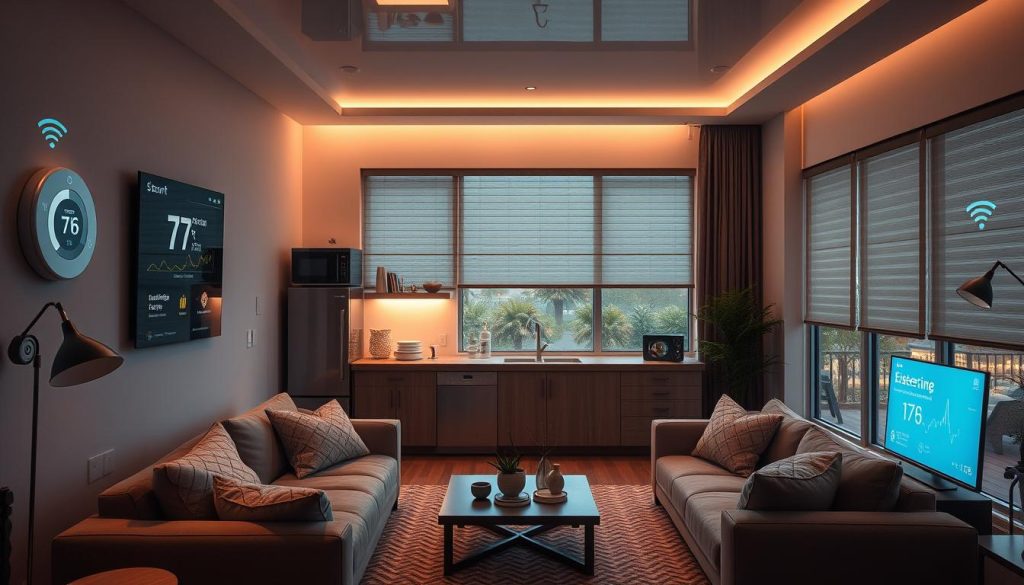
- Increased energy efficiency
- Enhanced convenience and control
- Improved home security
- Cost savings on energy bills
By integrating my smart devices, I can make my home more energy-efficient, convenient, and secure. With connected home energy solutions and smart energy tools, I can elevate my smart home. This way, I enjoy a more sustainable and comfortable living space.
| Device | Benefits |
|---|---|
| Smart Thermostats | Energy efficiency, convenience, and cost savings |
| Smart Lighting | Energy efficiency, convenience, and enhanced home security |
| Smart Appliances | Energy efficiency, convenience, and improved home management |
Monitoring and Analyzing Energy Consumption
As I learn more about smart home energy management, I see how key it is to watch and analyze my energy use. This lets me spot where I might be wasting energy and cut down on my bills. A study by the U.S. Department of Energy found that homeowners who keep an eye on their energy use can cut it by up to 15%.
To do this, I can use energy monitoring devices and home energy automation systems. These tools give me real-time data on how much energy I’m using. This way, I can track my energy use and make smart choices. Some perks of using these systems include:
- Real-time energy monitoring
- Personalized energy usage reports
- Automated energy-saving recommendations
Utilizing Apps for Energy Tracking
There are many apps out there that help me track my energy use. These apps work with my energy monitoring devices and home energy systems. They give me a full picture of how much energy I’m using.
Setting Up Notifications and Alerts
Setting up notifications and alerts helps me keep an eye on my energy use. I get reminders to use less energy, especially when it’s expensive or when I’m not home.
Automating My Energy Management
I’m diving into smart home energy management systems and I’m excited. Automated energy control lets me use energy wisely and cut down on waste. A report by the National Electrical Manufacturers Association shows smart thermostats can save homeowners up to $150 a year.
Smart home systems let me schedule devices for better energy use. I can check out smart thermostats and lighting. This way, I can use less energy when I’m not around. For instance, I can set lights to turn off when I leave the room or adjust the thermostat when I’m away.
Scheduling Devices for Energy Efficiency
- Programmable thermostats to adjust temperature settings
- Smart lighting systems to turn off lights when not in use
- Automated appliance control to turn off devices when not in use
Exploring Smart Thermostats and Lighting
Smart thermostats and lighting are key in smart home systems. They help me use energy better and save money. With automated control, I save time, money, and energy, making my home more efficient and green.
| Device | Energy Savings |
|---|---|
| Smart Thermostat | Up to $150 per year |
| Smart Lighting | Up to 75% energy savings |
Maintaining My Smart Home Energy System
To keep my smart home energy system running smoothly, I need to stay on top of maintenance. This includes regular updates and upgrades. This ensures I have the latest energy-efficient home technology. A survey by the Consumer Technology Association found that 80% of homeowners with smart home systems update their software regularly.
This helps prevent issues and ensures optimal performance. I’ve learned that using connected home energy solutions can help me identify and troubleshoot common issues. This includes connectivity problems or device malfunctions.
By addressing these problems quickly, I can minimize downtime and keep my system running efficiently. Some common maintenance tasks include:
- Checking for software updates and installing them promptly
- Monitoring device performance and replacing faulty devices
- Inspecting wiring and connections to ensure they are secure
By following these steps and utilizing energy-efficient home technology and connected home energy solutions, I can ensure my smart home energy system continues to provide energy savings and optimal performance.
Regular maintenance is essential to getting the most out of my smart home energy system. By staying on top of updates and troubleshooting issues, I can enjoy a seamless and energy-efficient experience in my home.
| Maintenance Task | Frequency | Importance |
|---|---|---|
| Software Updates | Monthly | High |
| Device Inspection | Quarterly | Medium |
| Wiring Inspection | Annually | Low |
Future Trends in Smart Home Energy Management
I’m excited to explore the latest trends in smart home energy management. It’s crucial to reduce energy use and move away from fossil fuels. Smart home systems and automation are key to achieving this.
A report by the International Energy Agency shows AI can cut energy use by up to 10% in smart homes. This is a big step towards a more sustainable home. I’m eager to learn how these systems can work with solar and wind power to cut fossil fuel use even more.
The Role of Artificial Intelligence
Artificial intelligence is becoming more important in smart home energy management. It helps optimize energy use and predict demand. AI analyzes my energy habits and offers tips to save energy.
Advancements in Renewable Energy Integration
Renewable energy integration is also advancing, helping homeowners like me use less fossil fuel. Key trends include:
- Solar systems that work with smart home systems to manage energy better
- Wind power for electricity, reducing fossil fuel use
- Energy storage for extra power from renewables and backup during outages
By using smart home systems, I can embrace these trends. This makes my home more sustainable and energy-efficient. I’m excited to learn more about these advancements and how to use them in my home.
| Smart Home Energy Management Systems | Benefits |
|---|---|
| Artificial Intelligence | Optimize energy usage, predict energy demand |
| Reneable Energy Integration | Reduce reliance on fossil fuels, lower energy bills |
| Energy Storage Systems | Store excess energy, provide backup power during outages |
Conclusion: Embracing Smart Home Energy Management
Looking back, I feel proud and excited about my journey to a greener home. Smart home energy management systems have made a huge difference. They’ve helped me use less energy and save money on bills.
These systems have also made my home more comfortable and easy to live in. They’ve helped the planet and improved my life.
My Journey Towards a Greener Home
This guide has taught me a lot about using energy wisely at home. I’ve learned about the key parts of smart home systems and how to connect devices smoothly. My home has changed a lot for the better.
Encouragement to Get Started Today
If you want a greener, cheaper home, start now. Smart home energy management is a great place to begin. It’s good for the planet and your wallet.
By using these new technologies, you’ll help the environment and save money. Begin your journey to a greener home today. Discover all the benefits of smart home energy management.

